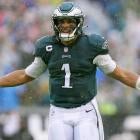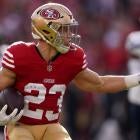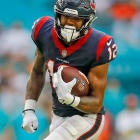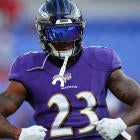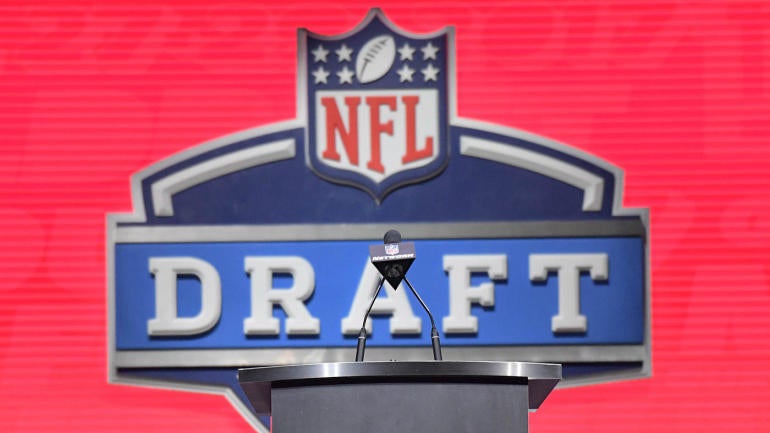
Back in March, shortly after the first wave of free agency, CBSSports.com explored how much and how little draft capital was controlled by each team. Using the trade value chart of SportsLine's R.J. White, we ranked the teams based on the cumulative value of each team's picks.
It is time to look back at how teams used that draft capital and what they were able to accomplish strategically.
Top five
1. Chicago Bears
1364.16 points on March 13 (entered draft with four picks)
- QB Caleb Williams, USC (Round 1, No. 1 overall)
- WR Rome Odunze, Washington (Round 1, No. 9 overall)
- OT Kiran Amegadjie, Yale (Round 3, No. 75 overall)
- P Tory Taylor, Iowa (Round 4, No. 122 overall)
- EDGE Austin Booker, Kansas (Round 5, No. 144 overall)
Chicago finished the draft with 1375.69 total points after adding the No. 144 overall selection in exchange for a 2025 fourth-round pick. The Bears dipped into future resources to add developmental pass rusher Austin Booker. The organization's plan was otherwise simple, adding pieces to the offense in support of incoming rookie quarterback Caleb Williams.
2. Washington Commanders
1236.73 points on March 13 (entered draft with nine picks)
- QB Jayden Daniels, LSU (Round 1, No. 2 overall)
- DT Johnny Newton, Illinois (Round 2, No. 36 overall)
- CB Mike Sainristil, Michigan (Round 2, No. 50 overall)
- TE Ben Sinnott, Kansas State (Round 2, No. 53 overall)
- OT Brandon Coleman, TCU (Round 3, No. 67 overall)
- WR Luke McCaffrey, Rice (Round 3, No. 100 overall)
- LB Jordan Magee, Temple (Round 5, No. 139 overall)
- S Dominique Hampton, Washington (Round 5, No. 161 overall)
- EDGE Javontae Jean-Baptiste, Notre Dame (Round 7, No. 222 overall)
Washington traded back from No. 40 overall, but picked up Nos. 50 and 53 overall in the process. When all was said and done, the Commanders had 1250.62 points in value. The draft results were a scatterplot, hitting nine different positions with its nine selections. In a separate column, I explored what new general manager Adam Peters accomplished in his first draft.
3. Arizona Cardinals
1149.57 points on March 13 (entered draft with 11 picks)
- WR Marvin Harrison Jr., Ohio State (Round 1, No. 4 overall)
- EDGE Darius Robinson, Missouri (Round 1, No. 27 overall)
- CB Max Melton, Rutgers (Round 2, No. 43 overall)
- RB Trey Benson, Florida State (Round 3, No. 66 overall)
- OL Isaiah Adams, Illinois (Round 3, No. 71 overall)
- TE Tip Reiman, Illinois (Round 3, No. 82 overall)
- CB Elijah Jones, Boston College (Round 3, No. 90 overall)
- S Dadrion Taylor-Demerson, Texas Tech (Round 4, No. 104 overall)
- EDGE Xavier Thomas, Clemson (Round 5, No. 138 overall)
- OT Christian Jones, Texas (Round 5, No. 162 overall)
- WR Tejhaun Palmer, UAB (Round 6, No. 191 overall)
- CB Jaden Davis, Miami (Fla.) (Round 7, No. 226 overall)
It would have been wise to wager that Arizona would not make its 11 selections, but it made even more. The Cardinals traded back twice and picked up an additional sixth-round pick. The trade back from No. 35 overall allowed them to add another selection in the top 100 overall. The team had 1169.47 points in value. Eight positions were addressed as the team doubled down on premium positions, such as edge rusher, wide receiver and cornerback.
4. New England Patriots
935.25 points on March 13 (entered draft with eight picks)
- QB Drake Maye, North Carolina (Round 1, No. 3 overall)
- WR Ja'Lynn Polk, Washington (Round 2, No. 37 overall)
- OT Caedan Wallace, Penn State (Round 3, No. 68 overall)
- OG Layden Robinson, Texas A&M (Round 4, No. 103 overall)
- WR Javon Baker, UCF (Round 4, No. 110 overall)
- CB Marcellas Dial, South Carolina (Round 6, No. 180 overall)
- QB Joe Milton III, Tennessee (Round 6, No. 193 overall)
- TE Jaheim Bell, Florida State (Round 7, No. 231 overall)
New England traded back three spots in the second round and the differential was negligible. The Patriots had eight picks worth 934.74 points. Seven of New England's eight selections, including the first five, were used on the offensive side of the ball to aid quarterbacks Drake Maye and Jacoby Brissett.
5. Los Angeles Chargers
803.20 on March 13 (entered draft with nine picks)
- OT Joe Alt, Notre Dame (Round 1, No. 5 overall)
- WR Ladd McConkey, Georgia (Round 2, No. 34 overall)
- LB Junior Colson, Michigan (Round 3, No. 69 overall)
- DT Justin Eboigbe, Alabama (Round 4, No. 105 overall)
- CB Tarheeb Still, Maryland (Round 5, No. 137 overall)
- CB Cam Hart, Notre Dame (Round 5, No. 140 overall)
- RB Kimani Vidal, Troy (Round 6, No. 181 overall)
- WR Brenden Rice, USC (Round 7, No. 225 overall)
- WR Cornelius Johnson, Michigan (Round 7, No. 253 overall)
Outside of offensive tackle Joe Alt and defensive tackle Justin Eboigbe, Los Angeles' draft class was rather flashy. Five of the team's nine picks were used on the cornerback and wide receiver positions as the Chargers look to rebuild both units. Keenan Allen and Mike Williams are no longer around to make plays in that offense. New general manager Joe Hortiz made just one trade: moving up three spots to No. 34 overall. The final point total was 803.72.
Bottom five
28. Miami Dolphins
334.65 points on March 13 (entered draft with six picks)
- EDGE Chop Robinson, Penn State (Round 1, No. 21 overall)
- OT Patrick Paul, Houston (Round 2, No. 55 overall)
- RB Jaylen Wright, Tennessee (Round 4, No. 120 overall)
- EDGE Mohamed Kamara, Colorado State (Round 5, No. 158 overall)
- WR Malik Washington, Virginia (Round 6, No. 184 overall)
- S Patrick McMorris, California (Round 6, No. 198 overall)
- WR Tahj Washington, USC (Round 7, No. 241 overall)
Miami added points over the course of the weekend, but it was not as impressive as it may sound. A 2025 third-round pick was the collateral damage in a trade with the Eagles as the Dolphins took sole possession of the No. 120 overall selection, which was used on Tennessee running back Jaylen Wright. It suggests that the franchise has big plans for Wright, though the vision may prove to be short-sighted as next year's class of running backs looks even stronger. The franchise had 353.29 total points.
29. Buffalo Bills
332.90 points on March 13 (entered draft with 11 picks)
- WR Keon Coleman, Florida State (Round 2, No. 33 overall)
- S Cole Bishop, Utah (Round 2, No. 60 overall)
- DT DeWayne Carter, Duke (Round 3, No. 95 overall)
- RB Ray Davis, Kentucky (Round 4, No. 128 overall)
- C Sedrick Van Pran-Granger, Georgia (Round 5, No. 141 overall)
- LB Edefuan Ulofoshio, Washington (Round 5, No. 160 overall)
- EDGE Javon Solomon, Troy (Round 5, No. 168 overall)
- OT Tylan Grable, UCF (Round 6, No. 204 overall)
- CB Daequan Hardy, Penn State (Round 6, No. 219 overall)
- OL Travis Clayton, England (Round 7, No. 221 overall)
Buffalo's draft strategy was similar to Chris Berman's call of the MLB All-Star Home Run Derby -- back, back, back. The Bills traded back three times and sent a fifth-round pick to the Bears in exchange for a 2025 fourth-round selection. They were the wide receiver merchants, allowing two other teams to take players at the position before grabbing their own at No. 33 overall. General manager Brandon Beane finished with 328.44 points of value, as well as the pick in next year's draft.
30. Kansas City Chiefs
309.27 points on March 13 (entered draft with seven picks)
- WR Xavier Worthy, Texas (Round 1, No. 28 overall)
- OT Kingsley Suamataia, BYU (Round 2, No. 63 overall)
- TE Jared Wiley, TCU (Round 4, No. 131 overall)
- S Jaden Hicks, Washington State (Round 4, No. 133 overall)
- C Hunter Nourzad, Penn State (Round 5, No. 159 overall)
- CB Kamal Hadden, Tennessee (Round 6, No. 211 overall)
- OG C.J. Hanson, Holy Cross (Round 7, No. 248 overall)
Kansas City traded up from each of its initial two picks to select targeted players. Neither trade was lopsided, however, as the Chiefs had just as many points (309.27) as they did nearly two months earlier.
31. Houston Texans
296.74 picks on March 13 (entered draft with eight picks)
- CB Kamari Lassiter, Georgia (Round 2, No. 42 overall)
- OT Blake Fisher, Notre Dame (Round 2, No. 59 overall)
- S Calen Bullock, USC (Round 3, No. 78 overall)
- TE Cade Stover, Ohio State (Round 4, No. 123 overall)
- LB Jamal Hill, Oregon (Round 6, No. 188 overall)
- RB Jawhar Jordan, Louisville (Round 6, No. 205 overall)
- EDGE Solomon Byrd, USC (Round 7, No. 238 overall)
- DT Marcus Harris, Auburn (Round 7, No. 247 overall)
- OG LaDarius Henderson, Michigan (Round 7, No. 249 overall)
Houston gained one selection, but lost less than two points in value. The Texans traded up twice and back once before securing a monopoly on seventh-round selections. Three of the final 19 picks belonged to the defending AFC South champions.
32. Cleveland Browns
153.37 points on March 13 (entered draft with five picks)
- DT Michael Hall Jr., Ohio State (Round 2, No. 54 overall)
- OG Zak Zinter, Michigan (Round 3, No. 85 overall)
- WR Jamari Thrash, Louisville (Round 5, No. 156 overall)
- LB Nathaniel Watson, Mississippi State (Round 6, No. 206 overall)
- CB Myles Harden, South Dakota (Round 7, No. 227 overall)
- DT Jowon Briggs, Cincinnati (Round 7, No. 243 overall)
Cleveland did not make any trades over the course of the draft but it did send reserve offensive tackle Leroy Watson to the Titans weeks earlier in exchange for a seventh-round selection, which became Myles Harden. The Browns took Michael Hall Jr. and Zak Zinter on Day 2 of the NFL Draft as they look to get younger and cheaper at those positions. Their final point value was 155.60.
















